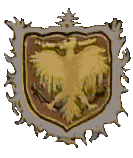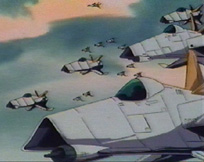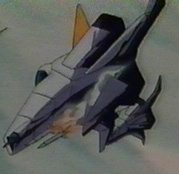

Designation:AF-2 Chimera Escort Fighter |

|
||||

|
|||||
| Total Length: | 20.1 m |
| Total Height: | 10.0 m |
| Total Wingspan: | 21.5 m |
| Total Dry Weight: | 35.7 metric tons |
While the electronics suites of these vehicles differed with their respective dates of operational service, all electronics were regularly updated, and during the Second Robotech War the following standard was in use:

The Chimera mounts three weapon bays: two on the upper sides, and one on the bottom. Each bay can mount:
The skin of the Chimera is composed of an advanced titanium-steel alloy. The armored skin stops all small arms fire, provides good to excellent protection against heavier infantry weapons, such as a 12.7mm machinegun round, and fair to good resistance to light mecha-mounted weaponry, such as the Zentraedi 22.3mm HE autocannon round. The Chimera provides full protection from nuclear, biological, and chemical hazards, using an overpressure cockpit environment activated by radiation and hazardous chemical sensors, or manually when biological warfare conditions are anticipated. The internal consumables supplies can provide atmosphere for three days maximum.
While the infant REF Navy chose a refit of the RDF Spacy's Vulture space fighter as its main heavy strike fighter, the ASC Tactical Space Corps chose a different set of criteria for the fighter that would fill this role on its warships. The TSC did not feel that the fighter's main gun need be as powerful as the Vulture's EP-100, and preferred a somewhat smaller installation. Missiles, on the other hand, were considered more essential to the fleet-defense duties by the ASC-TSC than the REF Navy, especially because the REF Navy expected to have less access to resupply and manufacturing facilities at this early date in its campaign. Finally, the TSC desired a greater autonomy for their fighter, meaning a greater delta-v capacity.
Essentially, the craft chosen that met these criteria was a very large, fusion-powered trans-atmospheric flying missile battery. As a strike fighter, the AF-2 Chimera could even surpass the REF's Beta, and served like the Legioss (Alpha/Beta pair) as fleet escort aircraft. However, because of its non-transformable nature, its historical importance is often overshadowed by the Veritechs. In addition to its load of no less than 27 heavy missiles, the Chimera carried a laser cannon in the nose.
The AF-2 Chimera was introduced in 2018, and served the TSC faithfully for a decade and a half, both in space, and to a limited extent, in the atmosphere. It was never officially withdrawn from service by the Southern Cross, and many remained in hiding during the Invid occupation at the moon bases. Almost all action seen by this spacecraft was against the Robotech Masters. Especially when armed with reaction missiles, the Chimera often heralded death for their assault carriers and the lighter capital ships.
It is uncertain if any of these craft engaged the Invid, as insufficient records of the Invid's initial attack survive to describe those fateful hours, though it is reasonably likely if the remaining Southern Cross fleets had any warning of the attack whatsoever.
Return to Southern Cross Index
Go to Robotech Reference Guide Home Page
Robotech (R) is the property of Harmony Gold. This document is in no way intended to infringe upon their rights.
Content by Pieter Thomassen and Peter Walker